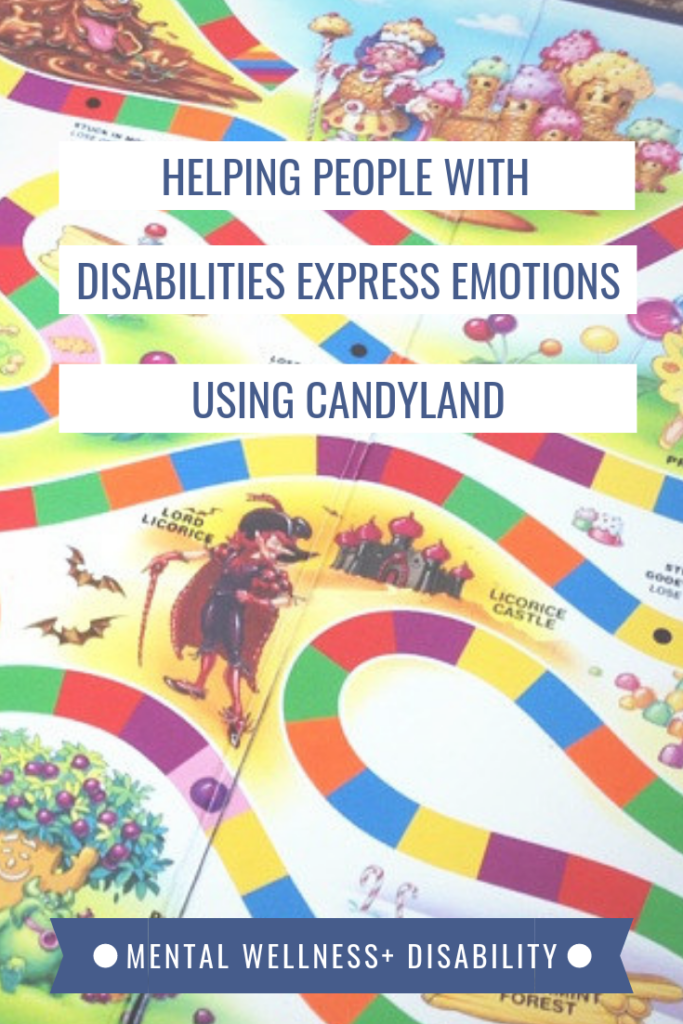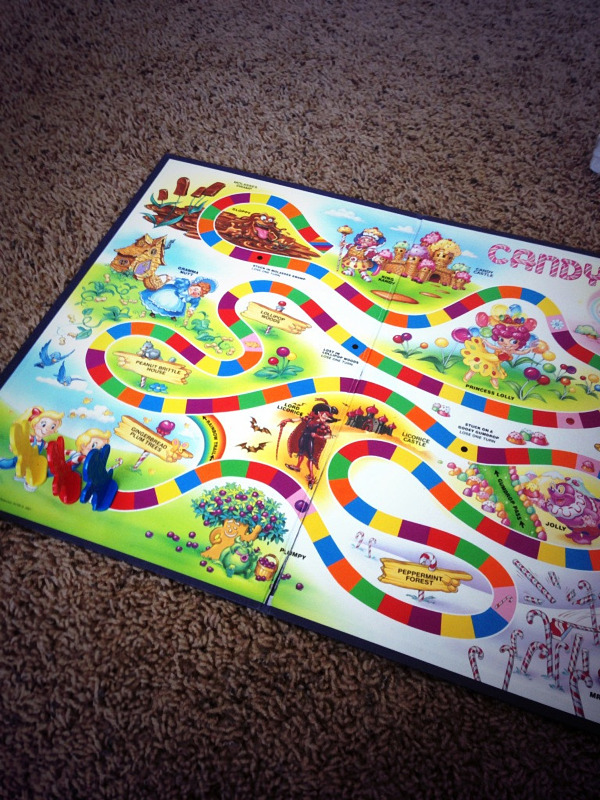Many of my counseling clients who have Autism and other developmental disabilities have low emotional intelligence when they enter therapy.
Emotional intelligence, in a very broad sense, refers to how well a person is able to identify and assess the emotions of other people, and to recognize and manage their own emotions.
Research and my own experience have taught me that helping people with disabilities express emotions and recognize emotions in others is tremendously beneficial for my clients. Their ability to communicate their needs and, more importantly, get their needs met, increases significantly when they are better able to recognize and identify and talk about their own feelings.
There are a lot of ways that a person with disabilities can learn to identify and express their emotions, but today I’m sharing one of my favorite tools that I use in therapy sessions with clients with disabilities: Candyland!
Yes, THAT Candyland!

Why use a game like Candyland to help people with disabilities express emotions?
I love this game because it’s often familiar, and even if it’s not, it’s usually simple enough to explain or modify to make it work for my client.
I also love it because it adds some whimsy to learning a skill that is tricky for many people with disabilities. The silliness is unexpected, especially in a therapy setting, and I find that that helps my clients loosen up and try a little harder than that might if we were using other, more traditional strategies.
Often times my clients have been told by their parents, teachers, siblings, other counselors, classmates, etc. that they ‘need to’ or ‘should’ do a better job of recognizing emotions in others and expressing their own feelings.
Over time, this causes a lot of anxiety, and a strong belief that they won’t ever be able to communicate how they’re feeling or to recognize emotions in others and respond in a way that’s helpful.
I find that using a game like Candyland can break through some of the anxiety and worry by lowering the stakes. Each square is nothing more than an opportunity to learn or hone their skills. If they don’t quite get it this turn, there’s always another turn to try again.
How to use Candyland to teach people with disabilities to express their emotions
Start with the right version of the game
First off, as both a therapist and a mom, I highly recommend you invest in an ‘old school’ version of the game, like this one:
The newer versions of the game use a smaller board, brighter colors, and (sorry, Hasbro) flimsier materials for the game pieces.
This isn’t great on any game night, but especially when using the game to encourage talking about difficult emotions and what to do with them, it’s important to minimize unnecessary frustration/distraction/stimulation. So, get the heavier, more durable board and pieces if you can, so that you can talk about frustration without causing more!
Play the game as usual, but with talking points
Follow the game instructions as written. Each time you land on a square, the color of the square represents a time that you felt a certain emotion. You should play along with your child to model how to play for them.
Orange = Excited
Green = Calm
Red = Angry
Purple = Scared/Anxious
Yellow = Happy
Blue = Sad
Then practice describing that emotion and the time you felt it using this script:
I felt ______
When______
Because_______
What helped was / It would have been helpful if / what was nice was____________
So, if you landed on blue, you might say:
I felt sad when my best friend moved to another state, because I wouldn’t see her every day. What helped was when I got to call her on the phone.
If ‘playing the game as usual’ is difficult for your child or client due to their disability, read on for some common modifications that I make when using Candyland to help people with disabilities express emotions.
When the game gets tough
Your child will most likely reach a time when it’s difficult for them to think of an emotion to relate to the color they’ve landed on.
When that happens, first, reflect back to them the challenge they’re facing, because this will show them that you understand that this is a difficult skill and that they’re working hard to master it:
You landed on purple for scared, but you’re having a tough time thinking of times when you’ve been scared / what helped you when you were scared.
Then, offer them a choice:
I can take a guess and talk about a time that I think you were scared, and then you can tell me if I’m right or wrong. Or, I can tell you about a time that I was scared, and see if that was scary to you too. Which would you like?
Side note – Thunderstorms, power outages, and witnessing vehicle accidents are great potential ‘shared scares’.
The most important thing to remember when playing Candyland to boost emotional intelligence
To help the person with I/DD understand and communicate their emotions is, be sure to validate what they are saying.
Perhaps your child describes feeling happy at a funeral. Or maybe they describe being afraid of a favorite teacher.
No matter what your child describes, it’s important that you not tell them they’re wrong.
Maybe they’ve actually gotten confused on matching the feeling to it’s name, but more likely, they’re describing an anomalous situation.
To get to the root of what your child is describing, accept what they say casually. Ask questions because you’re genuinely curious, not because you want to show your child that they’re wrong.
A real life example
I once had a counseling client with a Sensory Processing Disorder who had a difficult time identifying and describing his feelings. I recommended that he and his mom play Candyland at least once a week to build his skills.
The son described feeling angry at his favorite babysitter, Kim. The mom responded exactly as I’ve recommended; she stayed calm, didn’t tell him he was wrong, and instead just asked him for more details.
She said
That’s interesting. I would have thought that spending time with Kim would make you happy, like a yellow space. But you said spending time with Kim made you angry when you landed on the red space.
The son was quiet for a long time, and then said:
It’s mostly yellow, but then it’s red sometimes. Usually I’m happy when Kim’s my babysitter, but I didn’t like it the last time she was my babysitter.
The mom went on to ask what was different about the last time that the babysitter came to watch her son, and eventually realized that the babysitter had worn a perfume or used a cosmetic that smelled strongly and irritated her son. He’d found it difficult to concentrate on homework or to get through his nighttime routine because he’d been so bothered by the smell. He hadn’t slept well, and then had a tough day at school the following day.
Show the person with IDD that expressing how they feel causes good things to happen
The next time that the mom hired Kim, her son spoke with his favorite babysitter on the phone, using this script:
When you wear strong perfume, it makes me angry because it distracts me from my homework and my bedtime and makes me sleep badly. It would help me if you didn’t wear any perfume or strong smells when you come babysit me.
Not surprisingly, his babysitter was happy to oblige, and mom and son were both really pleased with how well he’d advocated for himself by communicating his feelings and needs.
Modifications that you can make
Ditch the Spinner
If the Candyland spinner is a distraction (it often is for my clients), just progress along the board in order of color without spinning. Since the board tiles always follow the same color pattern, it’s pretty simple to say “ok, you started on the red square, now you’ll move to the color after the next red square”.
Start with just one color
If your child is struggling with identifying and expressing their feelings, it may help to start by just progressing through the board one color at a time. Choose the emotion that’s easiest for them to identify (usually happiness), and just stop at every colored space that represents that feeling as you progress through the board.
As your child becomes more confident in their ability to discuss one emotion, eventually they will be ready to introduce the rest, one at a time. Be patient, and they’ll let you know when they’re ready to start talking about additional feelings.
Add a new challenge
If your child becomes very proficient at identifying and talking about their feelings, you can use the ‘two colored’ spins to talk about ‘what if’ situations.
So, rather than talk about a time you have already felt a certain emotion, use those spins to ask questions like:
The first day of school is coming up next week, what might make you feel excited on the first day of school?
Have you used Candyland or other board games to help a person with disabilities express their feelings? How did it go? Did I leave out any tips that were valuable to you? I hope you’ll leave a comment and share them here!












